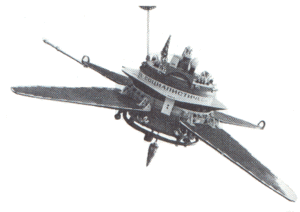Prognoz 9
This article relies largely or entirely on a single source. (March 2014) |

Prognoz 9 was a Soviet satellite. It was designed to investigate residual radiation from the Big Bang and gamma-ray bursts in deep space.
Mission
The mission was of Investigation of residual radiation from the Big Bang and gamma-ray bursts in deep space, and solar corpuscular and electromagnetic radiation plasma flows and magnetic fields in circumterrestrial space to determine the effects of solar activity on the interplanetary medium and the Earth's magnetosphere. In addition to the Soviet scientific apparatus, Prognoz 9 carried instruments built in Czechoslovakia and France.
Launch
Prognoz 9 was launched from the Baikonur Cosmodrome on 1 July 1983, using a Molniya-M / 8K78M-SOL carrier rocket.
Specifications
- Mass: 1,060 kg (2,340 lb)
- Periapsis: 380 km (240 mi)
- Apoapsis: 720,000 km (450,000 mi)
- Period: 38448.0 min (26.7 days)
- Inclination: 65.5°.
The spacecraft with highly eccentric orbit was spin stabilized with a period of 113 s. The spin axis pointed towards the Sun, and was repointed every few days.[1]
See also
Lua error in mw.title.lua at line 346: bad argument #2 to 'title.new' (unrecognized namespace name 'Portal').
References
- ^ Astronautix.com. "Prognoz". Archived from the original on 11 October 2009.
External links
- Prognoz 9 mission at NASA's HEASARC
- Prognoz 9 at Space Monitoring Data Center
- Prognoz program at Encyclopedia Astronautica
- Pages with script errors
- Short description with empty Wikidata description
- Articles needing additional references from March 2014
- All articles needing additional references
- Use British English from March 2014
- Use dmy dates from March 2014
- Spacecraft launched in 1983
- Spacecraft launched by Molniya-M rockets
- Soviet space observatories
- 1983 in the Soviet Union
- Czechoslovakia–Soviet Union relations
- France–Soviet Union relations
- Gamma-ray telescopes
- Soviet Union spacecraft stubs